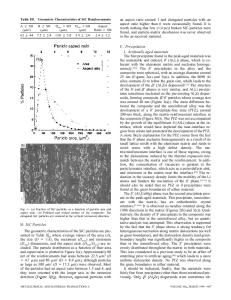The Tensile Properties and Microstructure of Ti-Tic Composites with Al Additions
- PDF / 1,937,113 Bytes
- 6 Pages / 420.48 x 639 pts Page_size
- 37 Downloads / 863 Views
THE TENSILE PROPERTIES AND MICROSTRUCTURE OF Ti-TiC COMPOSITES WITH Al ADDITIONS J. Chen, Z. Geng and B.A. Chin Materials Engineering, Auburn University, AL
36849
ABSTRACT The relationship between the tensile properties and microstructure of Ti-TiC composite materials with Al additions was investigated. Composites containing 40-50% TiC by volume were produced using standard casting procedures from the melt. Ultimate tensile strengths of 1113 MPa with 1-2 % ductility were found in these materials. Results show that the tensile properties are controlled by the size and distribution of TiC particles.
INTRODUCTION Monocarbides possess a number of properties which make them attractive candidates for high-temperature structural applications. However the use of these materials is limited by their lack of ductility. The Ti-TiC system is being investigated in an attempt to improve the mechanical properties through the presence of a ductile metal matrix. TiC, which acts as a ceramic and provides excellent high temperature properties, forms a particulate composite when combined with the Ti matrix. The specific strength of this material is much higher than normal high strength steels and super alloys, and the specific modulus is higher than commercially available Ti alloys. Materials reported in this paper differ from normal particulate composites in that general metallurgical casting techniques have been used instead of hot pressing. The Ti-TiC system studied here was produced by mixing graphite powder with titanium during melting, thus forming TiC particles as a second phase in a Ti matrix. The reinforcement TiC, in this case, was formed inside the material instead of being inserted into the molten metal. Interface wettability problems of the two materials are therefore avoided and well-bounded metal matrix particulate composites are achieved. Control of size and distribution of carbides by changing casting conditions can be used to optimize the mechanical properties. Another advantage of material produced in this manner is that they can be shaped by standard metallurgical processes such as hot rolling. Al additions have been shown to enhance the compressive strength greatly and very attractive high temperature strengths have been achieved [1). The Al is hypothesized to solid solution strengthen the Ti matrix and increase the order of the substoichiometric TiC, hence enhancing its strength. The purpose of this paper is to describe the results of a study which investigates the relationship between tensile properties and microstructure which is controlled by the casting procedure. EXPERIMENTAL PROCEDURE Specimen preparation Materials were produced by induction melting. Titanium (99.7% purity), graphite powder and aluminum (99.99% purity) were weighed and placed into a graphite crucible. An argon atmosphere was maintained during the heating and cooling of the melts. A tantalum suscepter was used to heat the sample and crucible and also acted as a getter material for free oxygen. An ultrasonic vibrator was used to promote sti
Data Loading...











